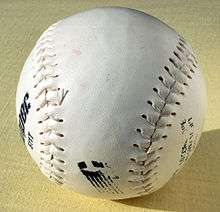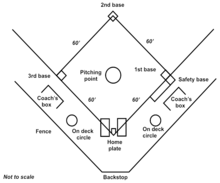Comparison of baseball and softball
A comparison of baseball and softball can be made as softball is directly descended from baseball. An observer of one game would find the other very similar, but there are several important rule differences.
Fastpitch softball is more popular in competitive leagues, especially at the college and international tournament levels, while slow pitch is more popular in recreational leagues where the relative skill levels of different players may vary widely. The different rules of slowpitch can be viewed as maintaining a competitive balance for less skilled players by eliminating certain strategies (e.g., base stealing and bunting) which require a high level of skill to counter. Additionally, recreational leagues may impose their own ground rules, either for competitive balance or to meet local constraints (e.g., a time limit may be imposed on a game to ensure multiple games can be played in one day).
Table of comparison
| Rule or Term | Baseball | Fastpitch softball | Slowpitch softball |
|---|---|---|---|
| Length of Game | 9 innings (7 in the high school level and in Minor League/college doubleheaders; 6 in Little League) | 7 innings (5 in certain college games) | 7 innings (5 in certain college games) |
| Equipment | |||
| Ball |  |
 |
|
| 9 inches (229 mm) in circumference | 12 or 11 inches (305 or 279 mm) in circumference, less dense than a baseball | often same as fastpitch softball, special 14 or 16 inch (356 or 406 mm) balls rarely used, less dense than a baseball | |
| Bat | No longer than 42 inches (1067 mm). Must be made of wood at the professional level; may be made of aluminum in high school and college. | No longer than 34 inches (864 mm). Most commonly made of composite materials, also aluminum, though wooden bats may be used | No longer than 34 inches (864 mm). Most commonly made of composite materials, also aluminum, though wooden bats may be used |
| Field | |||
| Layout diagram |  |
 |
|
| Baselines | 90 feet (27.43 m) | 60 feet (18.29 m) | Typically 60 feet or 65 feet (18.29 or 19.81 m); longer distances in some levels |
| Double first base | No, except in youth leagues such as Little League | Yes, all levels under ISF, NSA and ASA. Used on a state-by-state basis in high school. | Allowed. Runner reaches safety base in foul territory, fielders make play at regular 1st base |
| Outfield fence | Variable distance from home plate is mandatory in professional and university leagues and optional in youth leagues. Many youth leagues, such as Little League, use a constant distance from home plate. | Variable distance from home plate, depending on the individual field. (maximum of 250 ft/76 m) | Constant distance from home plate, although some less organized leagues have no fences. |
| Pitching distance | 60 feet, 6 inches (18.44 m) | Varies by level: 40 feet (12.19 m) (women's amateur), 43 feet (13.11 m) (women's high school (some states still play at 40), college and international) or 46 feet (14.02 m) (men) | Varies, typically 46 feet (14.02 m) |
| Pitcher's area | Raised sloping mound, radius of 9 feet (2.7 m), maximum height 10 inches (25 cm) | Flat circle, radius of 8 feet (2.4 m), marked with a white chalk circle | Pitching rubber only |
| Players | |||
| Fielders | Nine | Nine (before 1946, ten) | Ten (either a rover or shortfielder, or a left center and right center fielder) |
| Extra player | In some leagues, one designated hitter (DH) may bat in place of a fielder (usually only in place of the pitcher, but may bat for any defensive player under United States high school rules. Under U.S. collegiate rules, the starting pitcher may also be named the DH--P/DH on the lineup card--and be substituted for as if he were two different players.) | One designated player (DP) may bat in place of a fielder. | Some leagues allow an arbitrary number of extra players, up to the entire roster. |
| Substitution | No player substituted for may return to the game, including the replaced player if the DH takes a defensive position. EXCEPTION: Under high school rules in the United States, a player may be substituted for and return to the game once (this does not include "courtesy runners" for the pitcher and catcher). A pitcher who leaves the game may return, but only as a fielder (not the pitcher or DH). | Free defensive substitutions, provided each player occupies the same position in the batting order. Except in high school, if the DP takes a defensive position, the replaced player cannot return to the game. | Free defensive substitutions, provided each player occupies the same position in the batting order. |
| Batter | |||
| Bunting | Allowed. | Allowed. | Not allowed; batter is out if contact made. |
| Foul ball with two strikes | Batter is not out unless bunting. | Batter is not out unless bunting. | Batter is generally out. In many recreational leagues, a batter is allowed one foul ball with two strikes, with the second being an automatic out. |
| Hit by pitch | Awarded first base unless swing, pitch in strike zone, or no attempt made to avoid being hit. | Awarded first base unless swing, pitch in strike zone, or attempt made to intentionally be hit, although this is rarely called by the umpire. | Not awarded first base. |
| Runner | |||
| Base stealing | Allowed at any time the ball is live (i.e. when "Time" is not called). | Allowed once the ball leaves the pitcher's hand; runners may not leave base if the pitcher has the ball within the circle. | Generally not allowed, although some levels may permit stealing after a pitched ball crosses the plate or touches the ground. |
| Taking a lead from base | Same rules as for base stealing. | Same rules as for base stealing. | Runner is usually permitted to take a lead after the ball leaves the pitcher's hand, but must return to base between pitches if the ball is not put into play. Runner can be called out for taking a lead before the pitch. |
| Pitching | |||
| Delivery | Any method; in practice, usually overhand. | Underhand; no speed or arc restrictions. | Underhand; must travel in an arc and within certain height restrictions (a common range is between 6 and 12 feet (1.8 and 3.7 m) above the ground). Umpire can call a pitch "illegal" while in flight. |
| Illegal pitch | Most infractions punished as a balk. In United States high school baseball, the ball is automatically dead, and all runners advance one base. At the college and professional levels, a balk is considered an "option" play, and the batting team can opt to take the result of the play if it is more advantageous (e.g. home run). | The ball remains live. If the batter reaches base successfully and all runners advance, no penalty; otherwise, the play is negated, the pitch attempt is automatically a ball and runners advance one base. | The ball remains live. If the batter does not swing, the pitch is automatically a ball. |
See also
External links
- "Official Rules – MLB.com: Official info". Retrieved 2009-08-30.
- International Softball Federation Playing Rules Committee (2002). "Official Rules of Softball" (PDF). International Softball Federation. Archived from the original (pdf) on 2007-02-18. Retrieved 2009-08-31.
- NCAA Softball Rules Committee (2009). "Softball: 2009 Rules and Interpretations" (pdf). NCAA. ISSN 1089-0106. Retrieved 2009-09-22.